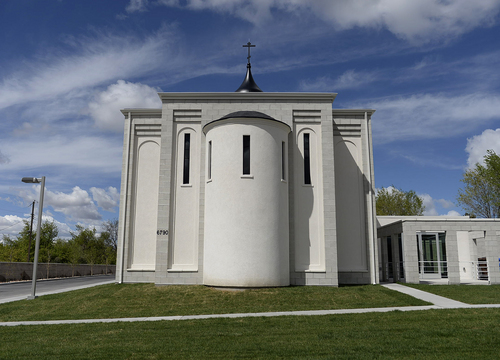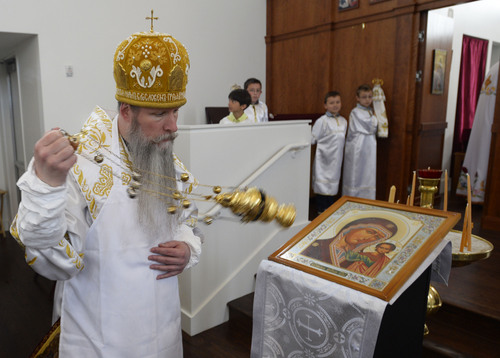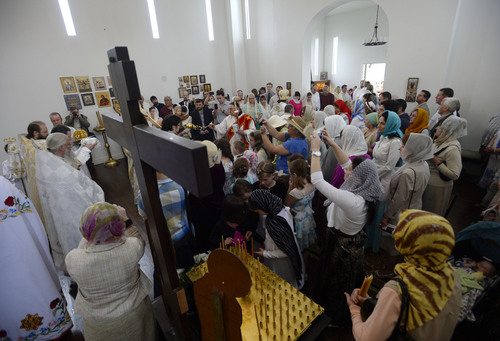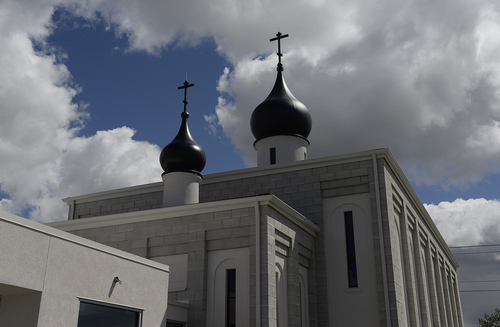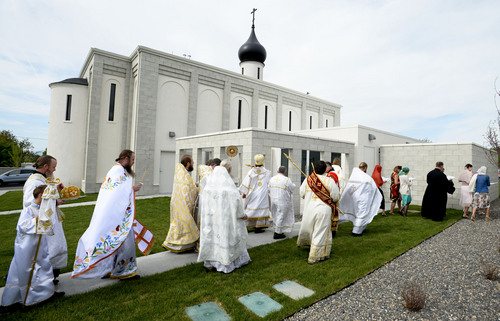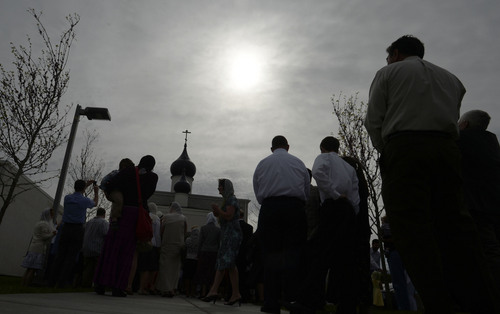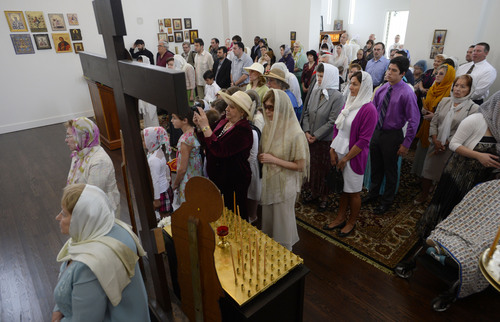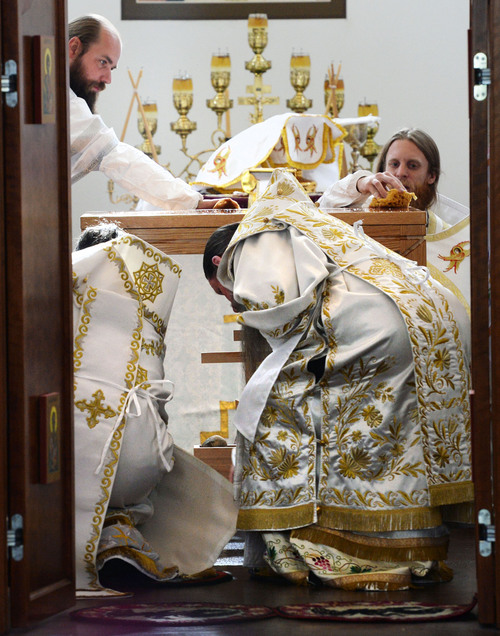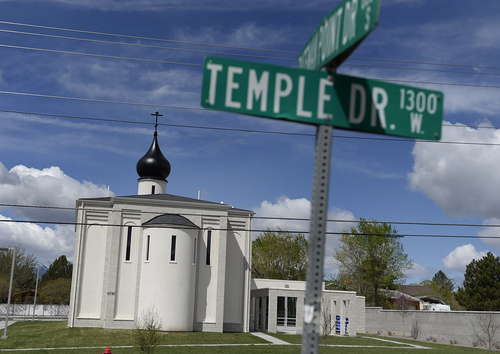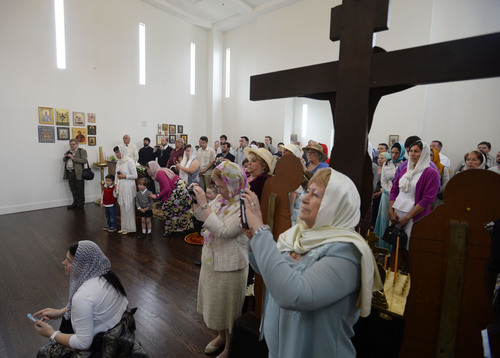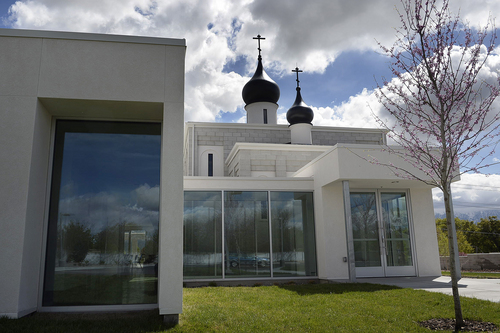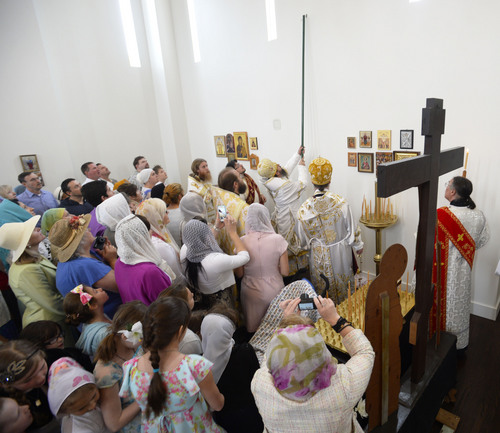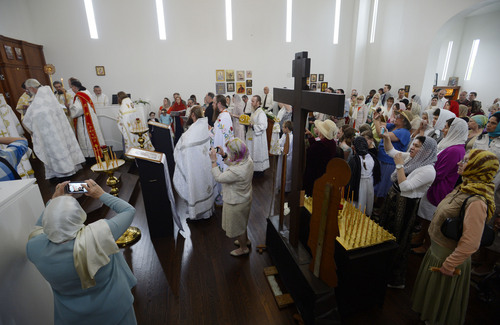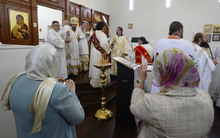This is an archived article that was published on sltrib.com in 2014, and information in the article may be outdated. It is provided only for personal research purposes and may not be reprinted.
West Jordan • Religious folk would call it a miracle.
A decade ago, when a pony-tailed Michael van Opstall showed up to teach at the University of Utah, there were only handfuls of Russian immigrants who desired Orthodox church services in their native language.
Van Opstall wasn't Russian, wasn't yet "Father Michael" and hadn't even been Orthodox for long, but he had, they say, a vision of an onion-domed "Ark of Salvation" rising up on Utah's desert landscape — and a lot of faith.
Thanks to the priest, the congregation and a mysterious donor, the just-completed St. George Russian Orthodox Church in West Jordan became a reality.
On Sunday, it was consecrated in a lengthy but somber ceremony of devotion and dedication.
Hundreds crowded into the sunlit nave, watching as more than a dozen visiting clerics participated in the liturgy, chanting in Russian and Slavonic (a kind of literary Russian much like Shakespearean English), while a 12-voice choir intoned sacred hymns.
Women in headscarves or hats and men in suits or their Sunday best repeatedly genuflected before the icons and then bowed, as the white-and-gold robed priests, bishops and archbishops cleansed and blessed every element in the new church, particularly the holy altar.
Archbishop Kyrill then led a procession of the leaders in a single file around the new space, sprinkling water on believers as well as icons, paintings, and chandeliers and tapping four tiny crosses on each side of the church — east, west, north and south — with oil.
In essence, the clergy baptized the church in an act of newness and birth.
It was a thrilling moment for church members who could scarcely have imagined this accomplishment when the parish was created in 2005.
At that time, van Opstall had just begun his path to the priesthood.
The charismatic leader had discovered Orthodoxy when he was at graduate school in Seattle. He was drawn to that faith from the Protestantism of his youth, he has said, because of its "purity of doctrine and connectedness to the beginning of Christianity."
The church he first attended happened to be Russian, so van Opstall became fluent in it. When he arrived in Utah, he was a reader at the church, which meant he could lead services but not officiate at Communion. By 2006, he was ordained a priest and could provide all the necessary rituals for the faithful in the congregation's rented spaces.
It was then that van Opstall, who still teaches math full time at the U., began to envision a permanent home for the parish, part of the Western American Diocese of the Russian Orthodox Church Outside of Russia.
That diaspora church split after the Communists took over Russia in the 1920s. Some stayed and cooperated with the new government, which was largely atheistic, even anti-religious; others fled the country.
Many churches and monasteries in what became the Soviet Union were either destroyed by the government or confiscated. Russian Orthodox believers living abroad refused to accept the authority of those who remained and thus set up their own leadership structure.
In 2007, these American believers united with the Russian Orthodox Church in their mother country but are governed independently.
Two years later, van Opstall and his congregation bought land for a church and commissioned some designs, but didn't have enough money to begin building.
That's where the donor comes in.
The church has about 200 members, but most of them are immigrants and not well-off, says Yuri Korkishko, the church warden, who manages the building and grounds. "We prayed to God and finally one guy called Father Michael and offered to donate the money for the church.."
Later, the would-be donor changed his mind, Korkishko explains, but, after suffering and then recovering from a disease, he called again and said he could offer "a million dollars for the new church."
And the donor was as good as his word.
"Nobody can explain it," Korkishko says. "Every day, I am thinking it is a dream."
The warden, like others, sees the donation as a result of van Opstall's divine entreaties.
"God gave him an errand," he says, "to organize a Russian Orthodox Church in Salt Lake City."
And so the priest prayed — and worked — the church into existence.
Along the way, van Opstall created a community of believers.
"Everybody has a story — we had mostly dramatic stories — of how we came to faith and to the Orthodox faith particularly," says Irina Romanovskaya, a longtime member of St. George parish. "When Father Michael came to town, he started gathering people together."
The priest "built this church spiritually," she says. "Without him, we would have nothing. He was strong in his faith and we all gathered around him."
Their newly dedicated church building, Romanovskaya adds, is "more than we could ever have asked for."
It will remain a symbol of centuries-old faith, reborn in a foreign land.
Twitter: @religiongal —



